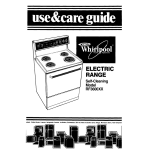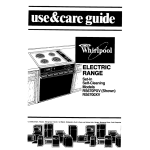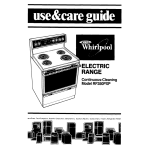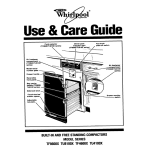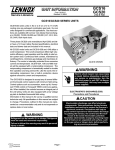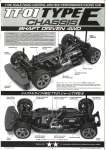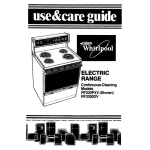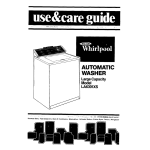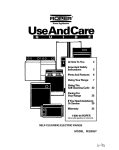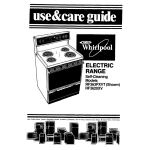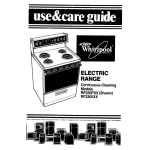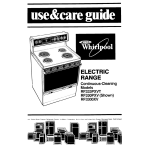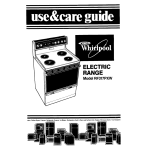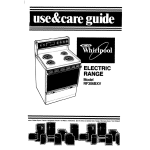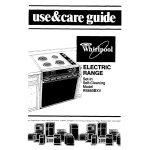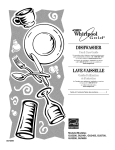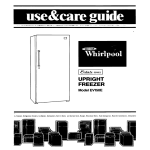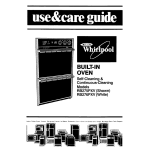Download Whirlpool RF33OOXV User's Manual
Transcript
CoZoz;ous-Cleaning RF330PXV (Shown) RF33OOXV Contents Page BEFORE YOU USE YOUR RANGE IMPORTANT SAFETY INSTRUCTIONS. ............... PARTS AND FEATURES. ......... USING YOUR RANGE. .......... Using the Surface Units. ...... Home Canning Information. Setting the Clock ............ Using the Minute Timer. ...... Baking or Roasting .......... Setting the Oven Controls How To Position Racks andPans ............... Broiling ..................... Setting the Oven Controls . . Custom Broil .............. Broiling Tips ............... Adjusting the Oven TemperatureControl ...... 2 3 5 6 6 8 9 9 10 10 11 12 12 13 13 Page 15 The Oven Vent . . . . . . . . . . The Storage Drawer . . . . . . . 16 Optional Door Panel Pat . . . 17 CARING FOR YOUR RANGE . . 17 17 Control Panel and Knobs . . Surface Units and Reflector Bowls . . . . . . . . . . . . . . . . . 18 Lift-Up Cooktop . .. . 20 20 The Oven Door . .. . 21 The Oven Window . . . . . . . The Continuous-Cleaning 22 Oven . . . . ..... .... Cleaning Chart . . . . . . . . . 24 25 The Oven Light . . . . . . . . . . . IF YOU NEED SERVICE OR ASSISTANCE. . ......... . WHIRLPOOL RANGE WARRANTY ....... .... 26 28 14 01990 Whirlpool Corporation Before you use your range You are responsible l l l l l l for: Reading and following all safety precautions in this Use and Care Guide. Installing and leveling the range on a floor strong enough to support its weight, and where it is protected from the elements. (See the Installation Instructions.) Making sure the range is not used by anyone unable to operate it properly Properly maintaining the range. Using the range only for jobs expected of a home range. Making sure the range is secured by a properly installed anti-tip bracket, with a rear leveling leg positioned under bracket. Remove the Consumer Buy Guide label. It will be easier to remove before the range is used. To remove any remaining glue: l Rub briskly with thumb to make a ball, then remove. or l Soak area with liquid hand dishwashing detergent before removing glue as described above. Do not use sharp instruments, rubbing alcohol, flammable fluids or abrasive cleaners. These can damage the finish. See “Important Safety Instructions” on page 3. IMPORTANT SAFETY INSTRUCTIONS To reduce the risk of fire, electrical shock, injury to persons, or damage when using the range, follow basic precaullons, including the followlng: l l Read all instructions before using the range. Install or locate the range only in accordance with the provided Installation Instructions. It is recommended that the ran e be installed by a qualifie 8 installer. The ran e must be properly connet 3ed to electrical supply and gr%nded. mTo reduce the risk of tipping of the appliance, the appliance must be secured by a properly installed anti-tip bracket. To check if the bracket is installed properly, remove the storage drawer [see page16 and verify that the antitip brat 1,et is engaged. l Do not use the range for warmin or heating the room. Persons cou 9d be burned or injured, or a fire could start. b Do not leave children alone or unattended in area where the range is in use. They should never be allowed to sit or stand on any part of the range. They could be burned or injured. b Do not wear loose or hanging garments when using the range. They could ignite if they touch a hot surface unit or heating element and you could be burned. b Do not repair or replace any part of the range unless specifically recommended in this manual. All other servicin should be referred to a qualified 9echnician. n Do not store flammable materials in or near the range. They could explode or burn. n Do not use water on grease fires. l l l l l l Never pick up a flaming pan. Smother flamin pan on cooktop by covering wit1 a well-fitted lid, cookie sheet or flat tray. Flaming grease outside of pan can be extinguished with baking soda or, if available, a multipurpose dry chemical or foam-type extinguisher. Use only dry potholders. Moist or damp potholders on hot surfaces may result in burns from steam. Do not let potholder touch hot heating elements. Do not use a towel or bulky cloth for a potholder. They could catch on fire. Select a pan with a flat bottom that is about the same size as the surface unit. If pan is smaller than the surface unit, some of the heating element will be exposed and may result in the igniting of clothing or potholders. Correct pan size also improves cooking efficiency. Never leave surface units unattended at high heat settings. A boil-over could result and cause smoking and greasy spill-avers that may ignite. Make sure the reflector bowls are in lace during cooking. Cooking WI-Phout reflector bowls may subject the wirin and components underneath tRem to damage. Do not line reflector bowls with aluminum foil or other liners. Improper installation of these liners may result in a risk of electric shock or fire. Check to be sure glass cooking utensils are safe for use on the cooktop. Only certain types of glass, glass-ceramic, ceramic, earthenware or other glazed utensils are suitable for cooktops without breaking due to the sudden change in temperature. continued on next page 3 l l l l l l l Turn pan handles inward, but not over other surface units. This will help reduce the chance of burns, igniting of flammable materials, and spills due to bumping of the pan. Do not soak removable heating elements in water. The element will be damaged and shock or fire could result. Use care when opening oven door. Let hot air or steam escape before removing or replacing food. Do not heat unopened containers. They could explode. The hot contents could cause burns and container particles could cause injury. Keep range vents unobstructed. Always position oven racks in desired location while oven is cool. If rack must be moved while oven is hot, do not let potholder contact hot heating element in oven. Do not clean door seal. It is essential for a good seal. Care should be taken not to rub, damage, or move the seal. Clean only parts recommended in this Use and Care Guide. l l l Do not use oven cleaners. No commercial oven cleaner or oven liner protective coating of any kind should be used in or around any part of the oven. Do not store things children might want above the range. Children could be burned or Injured while climbing on it. Do not touch surface units, areas near units, heating elements or interior surfaces of oven. Surface units and heating elements may be hot even though they are dark in color. Areas near surface units and interior surfaces of an oven become hot enough to cause burns. During and after use, do not touch, or let clothing or other flammable materials contact surface units, areas near units, heating elements or interior surfaces of oven until they have had sufficient time to cool. Other surfaces of the range may become hot enough to cause burns; such as, the oven vent opening, the surface near the vent opening, the cooktop, the oven door and window. . FOR YOUR SAFETY. DO NOT STORE OR USE GASOLINE OR OTHER FLAMMABLE VAPORS AND LIQUIDS IN THE VICINITY OF THIS OR ANY OTHER APPLIANCE. THE FUMES CAN CREATE A FIRE HAZARD OR EXPLOSION. - SAVE THESE INSTRUCTIONS Thank you for buying a Whlrlpooi appliance. mail the Owner Reglstratlon Card provlded Please complete with this product. and Then complete the form below. Have this information ready if you need service or call with a question. l l Copy model and serial numbers from plate (behind the oven door on the oven frame] and purchase date from sales slip. Keep this book and the sales slip together in a handy place. Model Number Serial Number Purchase Date Service Company 4 Phone Number Parts and features Models RF330PXV and RF3300XV LEFTREAR CONTROL KNOB LIGHT CLOCK/ OVEN TEMPERATURE MINUTE TIMER CONTROL t INDICATOR LIGHT SURFACEUNIT MARKER RIGHT FRONT\ CONTROL KNOI OVEN VENl CONTROL PANEL ONE-PIECE CHROME REFLECTORBOWL MODEL AND CONTINUOUSCLEANING OVE REMOVABLE STORAGE DRAWER Using your range Using the Surface Units Surface Unit Indicator lights One of the surface unit indicator lights on the control panel will glow when a surface unit is on. Control knobs before tumlng must be pushed in them to a setting. They can be set anywhere between HI and OFF. Surface Unit Markers The solid dot in the surface unit marker shows which surface unit is turned on by that knob. Burn and Fire Hazard Be sure all control knobs are turned to OFF and all indicator lights are OFF when you are not cooklng. Someone could be burned or a fire could start if a surface unit is accidentally left ON. Untti you get used to the settings, use the following as a guide. For best results, start cooking at the high settings; then turn the control knob down to continue cooking. Turn on the surface unit only after placing filled pan on unit. Use HI to start foods cooking; to bring liquids to a boil. Use MED-HI Use MED Use MED-LO Use LO to to hold a rapid boil; to fry chicken or pancakes. for gravy, puddings and icing; to cook large amounts of vegetables. to keep food cooking after starting it on a higher setting. keep food warm until ready to serve. Set the heat higher or lower within the LO band to keep food at the temperature you want. Cookware There is no one brand of utensil that is best for all people. Knowing something about pan materials and construction will help you select the right cooking utensils for your needs. 1. Use only flat-bottomed utensils that make good contact with the surface units. To check the flatness of a utensil: Turn it over and check the bottom of the pan by placing a ruler across it. Rotate the ruler in all directions. There should be no gaps between the pan and the ruler. 2. The pan should have straight sides and a tight:fitting lid. 3. Choose medium to heavy gauge (thickness) pans that are fairly lightweight. Remember that a very heavy pan will be even heavier when filled with food. 6 4. The pan material (metal or glass] affects how fast heat transfers from the surface unit through the pan material and how evenly heat spreads over the pan bottom. 5. Handles should be made of a sturdy, heat-resistant material and be securely attached to the pan. l l l l l Burn, Personal InJury and Product Damage Hazard It the pan is too small for the surface unit, you could be burned by the heat from the exposed section of the surface unit. Use correctly sized cooking utensils to prevent InJury. Not all glass, glass-ceramic, ceramic, earthenware and other glazed utensils are safe for cooktop cooking. Some will crack or break wlth sudden temperature changes, which could result in personal injury. If a surface unit stays red for a long time, the bottom of the pan is not flat enough or Is too small for the surface unlt. Prolonged usage of incorrect utensils for long periods of tlme can result in damage to the surface unit, cooktop, wiring and surroundlng areas. To prevent damage, use correct utensils, start cooking on HI and turn control down to continue cooklng. Do not leave an empty utensil, or one which has boiled dry, on a hot surface unlt. It can overheat and may damage the utensli or surface unit. Do not use canners, woks and speclaity utensils with rounded, warped, ridged or dented bottoms. These could cause severe overheating which damages the utensil and/or surface unlt. Home Canning Information To Protect Your Range: 1. Use flat-bottomed canners for best results. Do not use canners with dented or ridged (porcelain enamel-ware] bottoms. They do not make good contact with the surface unit and cause severe over-heating which damages the cooktop. 2. For best results, use a canner which can be centered over the surface unit. Large diameter canners, if not properly centered,trap heat and can cause damage to the cooktop. 3. Do not place canner on two surface units at the same time. Excessive heat build-up will damage the cooktop. 4. Alternate surface units, This allows the surface units to cool down between batches. 5. Start with hot water. This reduces the time the control is set on high. Reduce heat setting to lowest position needed to keep water boiling. 6. Keep reflector bowls clean for best heat reflection. 7. To prolong the life of the elements: l Prepare small batches at a time. l Do not use elements for canning all day. Optional Canning Kii (Part NO. 242905) The large diameter of most water-bath or pressure canners combined with high heat settings for long periods of time can shorten the life of regular surface units and cause damage to the cooktop. If you plan to use the cooktop for canning, we recommend the installation of a Canning Kit. Order the kit from your Whirlpool dealer or authorized WhirlpoolSM service company. 8 Setting the Clock Push In and turn the Minute 1. Push In Minute turn clockwlse llmer llmer Knob to set the Clock. Knob and until clock shows the right time of day. 2. let the Mlnute llmer Knob pop out. Turn clockwise until Minute Timer hand points to OFF.The clock sefflng will change It you push In the knob when tumlng. Using the Minute Timer The Minute Timer does not start or stop the oven. It works like a kitchen timer. Set it in minutes up to an hour. You will hear a buzzer when the set time is up. DO NOT PUSH IN THE KNOB when setting the Minute Timer. 1. Without pushlng lt In, turn the Minute Timer Knob until the timer hand passes the setting you want. PUSHING SEWING. pushlng In, turn the knob back to the setting you want. When the tlme Is up, a buzzer will sound. To stop the buzzer, turn the Minute Timer hand to OFF. 2. Without IN AND TURNING THE MINUTE TIMER KNOB CHANGES THE CLOCK 9 Baking or Roasting Setting the Oven Controls 1. Position the rack(s) properly before turning on the oven. To change rack posltlon, lift rack at front and pull out. For information on positioning racks, see “How To Position Racks and Pans” on page 11. 3. Set the Oven Temperature Control to the baking temperature you want. The Oven Indicator Light will come on. The oven is preheated when the Oven Indicator Light first goes off. NOTE: Do not preheat oven when roasting or cooking items such as casseroles. 5. When baking is done, turn both the Oven Selector and Oven Temperature Control to OFF 10 2. Set the Oven Selector to BAKE. 4. Put food in the oven. During baking, the elements will turn on and off to keep the oven temperature at the setting. The Oven Indicator Light will turn on and off with the elements. The top element helps heat durlng baklng, but does not turn red. How To Position Racks and Pans The rack(s) should be placed so the top of the food will be centered in the oven. Always leave at least 1Yzto 2 inches (4-5 cm) between the sides of the pan and the oven walls and other pans. For proper l l l cooklng, follow these guldelines for specific foods: Angel and bundt cake pans, yeast breads, frozen pies, large roasts and turkeys- place rack on lowest level Casseroles, muffins, most quick breads and meats - place rack on second level from bottom Cookies, biscuits, cakes and non-frozen pies - place rack on second or thir level from bottom When baking on two racks, arrange racks on bottom and third level from bottom. Fire and Personal Injury Hazard Always posltlon oven racks In deslred location before turnlng oven on. Be sure the racks are level. l If racks must be moved while oven is hot, use potholders or oven mitts to protect hands. l Do not let potholders or oven mitts contact hot heating elements. l Always use a dry potholder or oven mitt to change racks or handle utensils In the oven. Do not use a damp potholder or oven mltt. Steam burns could result. Fallure to follow the above precautions may result In fire or personal InJury. l The hot air must circulate around the pans in the oven for even heat to reach all parts of the oven. For Besf Alr Clrculalfon: Place the pans so that one is not directly over the other. l Allow lYz-2 inches (4-5 cm) of space around each pan and between pans and oven walls. l Use only one cookie sheet in the oven at one time. Use the following as a guide to determine where to place the pans. l One Pan Place in the center of the oven rack. Two Pans Place in opposite corners of the oven rack. NOTE: “Oven peeking” may cause heat loss, longer cooking times and unsatisfactory baking or roasting results. Rely on your timer. Broiling Setting the Oven Controls 1. Position the rack properly before turning on the oven. The oven rack should be positioned so that the surface of the food is at least 3 inches (7.4 cm] away from the broil element. 12 2. Put the broiler pan and food on the rack. 3. Close the door to the Broil Stop position (open about 4 inches, 10.2 cm). The door will stay open by itself. NOTE: The door must be partly open whenever the oven is set to BROIL.Leaving the door open allows the oven to maintain proper temperatures. 4. Set the Oven Selector and Oven Temperature Control to BROIL. NOTE: Do not preheat oven when broiling. 5. When broiling is done, turn both the Oven Selector and Oven Temperature Control to OFF. Custom Broil l If food is cooking too fast, turn the Oven Temperature Control counteruntil the Oven Indicator Light goes off. If YOU Want the food to broil slower from the start, set the Oven Temperature Control between 150” and 325°F (65.5” and 162.7”C). The lower the temperature, the slower the cooking. clockwise l The Oven Selector must be on BROIL for all broiling temperatures. Broiling Tips l l l Use the broiler pan and grid for broiling. They are designed to drain excess liquid and fat away from the cooking surface to help prevent spatter, smoke or fire. Refer to a broiling chart in a reliable cookbook for correct broiling times. After broiling, remove the broiler pan from the oven when you remove the food. Drippings will bake on the pan if it is left in the heated oven. Flre Hazard ) Place meat the correct distance from the element. Meat placed too close to the element may spatter, smoke, burn or catch flre during brolllng. 1 To ensure adequate grease dralnage, do not use cookie sheets or simllar pans for brolllng. Also, covering the broiler grld wlth foil Is not recommended. Poor dralnage of grease may result in fire. If foil is used, cut sltts in toll to correspond wlth all openings In broiler grid. Grease can then draln away and cool In pan. Adjusting the Oven Temperature Control Does your oven seem hotter or colder than your old oven? The temperature of your old oven may have shifted gradually without your noticing the change. Your new oven is properly adjusted to provide accurate temperatures. But when compared to your old oven, the new design may give you different results. If after using the oven for a period of time, you are not satisfied with the temperature settings, they can be adjusted by following these steps: LOCKING 1. Pull the Oven Temperature Control Knob straight off. 2. Loosen the locking screws inside the control knob. Note the posltlon of the notches. TOOTN NOTCHES move the tooth a notch closer to LO. Each notch equals about 10°F (5°C). 3. To lower the temperahtre, TooTn move the tooth a notch closer to HI. Each notch equals about 10°F[SOC). lighten the locking sorews and 4. To ralse the temperature, replace 14 NOTCHES the control knob. The Oven Vent Hot air and moisture escape fTom the oven through a vent under the right rear surface unit. You can cook on the unit, or keep food warm on it while the oven is on. Burn Hazard If you leave a utensil on the rlght rear rurlace unit, use potholders when removlng lt. Pan handles can become hot enough to burn. Plastic utensils leff over the vent can melt. The vent is needed for air circulation Do not block the vent. Poor baking can result. The Storage Drawer The storage drawer is for storing pots and pans. The drawer can be removed to make it easier to clean under the range, and to check for installation of the anti-tip bracket. Use care when handllng the drawer. Removing the storage drawer 1. Empty drawer of any pots and pans.before removing drawer. Pull drawer straight out to the first stop. Lift front and pull out to the second stop. Replacing 2. Lift back slightly and slide drawer all the way-out. the storage drawer :I! -KY- 1. Fit ends of drawer sliz rails into the drawer guides on both sides of opening. 2. Lift drawer froxnd push in until metal stops on drawer slide rails clear white stops on drawer guides. Lift drawer front again to clear second stop and slide drawer closed. To verity the an&tip Is engaged: Remove the storage drawer. Look to see if the anti-tip bracket is attached to floor with screws. l Make sure one rear leveling leg is positioned under the anti-tip bracket. 0 See Installation Instructions for further details. l l 16 brucket Optional Door Panel Pat (Model RF33OPXV) If you would like to change the color of your oven door glass to white or almond, you can order one of these kits: White (Kit No. 814069) or Almond [Kit No. 814070) from your Whirlpool Dealer. The kits include easy installation instructions, Caring for your range Control Panel and Knobs I Burn and Electrical Shock Hazard Make sure all controls are OFF and the range Is cool before cleaning. Fallure to do so can result In burns or electrlcal shock. 1. Turn control knobs to the OFF position. 2. Pull control knobs straight off. 3. Use warm soapy water or spray glass cleaner, and a soft cloth, to wipe the control panel. Rinse and wipe dry. 4. Wash control knobs in warm soapy water. Rinse well and dry. Do not soak. 5. Replace control knobs by pushing them firmly into place. NOTE: When cleaning, never use steel wool, abrasives, or commercial oven cleaners which may damage the finish. After cleaning, make sure all control knobs point to the OFF position. Reflector Bowls Burn and Electrlcal Shock Hazard Make sure all surface units are OFF before removlng surface unlts and reflector bowls. Failure to do so can result In burns or elect&al shock. ‘I. Turn off all surface units. 2. Lift the edge of the unit, opposite the receptacle, just enough to clear the element hold down clip and the reflector bowl. 3. Pull the surface unit straight away from the receptacle. 4. Lifl out the reflector bowl. See “Cleaning Chart” on page 24 for cleaning instructions. continued 18 on next page Replacing l l 1. Burn, Electrlcal Shock and Fire Hazard Make sure all surface unlts are OFF before replacing surface units and reflector bowls. Failure to do so can result in burns or electrical shock. Do not line the reflector bowls wlth foil. Fire or electrical shock could result. Turn off ail surface units. 1.Hold the surface unit as level as possible with the terminal just started into the receptacle. Push the surface unit terminal into the receptacle. Line up openings in the reflector bowl with the surface unit receptacle and the element hold down clip. #.When terminal is pushed into the receptacle as far as it will go, push down the edge of the surface unit opposite the receptacle. The element hold down clip will keep the surface unit from moving around. NOTE: Reflector bowls reflect heat back to the utensils on the surface unlts. They also help catch spills. When they are kept clean, they reflect heat better and look new longer. If a reflector bowl gets dlscolored, some of the utensils may not be flat enough, or some may be too large for the surface unit. In either case, some of the heat that’s meant to go Into or around a utensil goes down and heats the reflector bowl. This extra heat can discolor it. Lift-Up Cooktop 1. Lift front of cookto~ at both front corners until the support rods lock into place. l l Personal lnlury and Product Damage Hazard Be sure both support rods are fully extended and in the locked posltlon. Failure to do so could result In personal Injuw from the cooktop accldentally falling. Do not drop the cooktop. Damage can resutt to the porcelain and the cooktop frame. 2. Wipe with warm, soapy water. Use a soapy steel wool pad on heavily-soiled areas. 3. To lower the cooktop; lift cook-top from both sides while pressing the support rods back to unlock them. Lower the cooktop into place. The Oven Door Removing the oven door will help make it easier to clean the oven. Burn and Electrical Shock Hazard Make sure all controls are OFF and the oven is cool before removing oven door. Failure to do so can result in burns or electrical shock. 1. Open the door to the first stop position. 2. Hold the door at both sides and lift lt at the same angle lt Is in. fit the bottom corners of the door over the ends of the hinges. Push the door down evenly. The door will close only when it is on the hinges correctly. 3. To replace, 20 The Oven Window If your range has an oven window instead of the black glass door,the outer glas and frame can be removed for cleaning. DO NOT TAKE APART A BLACK 6LASS DOOR. To remove the outer window: c Burn and Electrical Shock Hazard Make sure all controls are OFF and the oven Is cool before removing the outer window. Fallure to do so can result In burns or electrical shock. 1. Turn off all controls. With the door closed, remove the screws from the top of the outer window frame. 2. Slightly tip the window and frame out from the top. 3. Wt~sb$~~~r;ds,~~ft up on both To replace the outer window: Fit the bottom tabs of the frame into the bottom of the window opening. 2. Push the top of the frame into place while pushing down. 3. Replace the screws. The Continuous-Cleaning Oven Standard oven walls are coated with smooth porcelain, Your ContinuousCleaning oven walls are coated with a special, rougher porcelain. A fat spatter beads up on the smooth surface, but spreads out on the rougher surface. The bead of fat on the smooth surface chars and turns black. The spread-out fat on the rough surface gradually burns away at medium to hlgh baking temperatures so the oven can return to a presentably clean condition. Using Foil Using foil on the oven bottom is recommended to catch sugar and starchy spills from pies and casseroles. It must be used properly. Cut foil from a roll of heavy-duty la-inch (45 cm) aluminum foil, or buy a foil kit (Par-l No. 241430) fromyour Whirlpool Appliance dealer. I l l Burn, Electrical Shock and Product Damage Hazard Make sure all controls are OFF and the oven Is cool betore using foil. Failure to do so can result In burns or electrical shock. Do not let foil touch the bake element. It could damage the element. Make sure foil Is flat on the bottom and away from the bake element. 1. Turn off all controls, 2. Lift the Cool bake element slightly to Ilft the teet off the oven bottom. 3. Slide the foil under the bake element. Make sure the foil is cen- fered and long enough to start up both side oven walls without wrinkling. For proper baking, lower the bake element so all feet rest solldly on the toll. 22 Cleaning Tips 1. The oven window al ?d racks are ntot coated. C 2. The oven door does not get as hot as the walls. needed. 3. If you do more broiling than baking, hand cleaning 4. Use aluminum foil on the oven bottom according may not burn away and could stain the bottom. may be needed. to instructions. Spill-overs Hand Cleaning Personal Injury Hazard Do not use oven cleaning products. Some can become trapped in the porcelain surface and give off harmful tumes. RACKS - Use a soapy steel wool pad for best cleaning results. Rinse well. WINDOW-Keep clean with hot soapy water. Use a plastic scrubbing pad for heavily-soiled areas. Rinse well. Do not use steel wool or abrasive cleansers. WALLS AND DOOR -Wash with hot soapy water. Use a steel wool pad o plastic scrubbing pad for heavilysoiled areas. Rinse well. Cleaning Chart PART EXiMi0t suttaces (potcelaln and chrome flnlsh) (chrome flnlsh) Surface unlfs WHAT TO USE Warm soapy water and a soft cloth. Non-abrasive plastic scrubbing pad for heavilysolled areas. . Wipe off regularly when range is COOI. . Do not allow tood confalnlng acids (such as vlnegat, tomato, lemon Juice or milk) to temaln on sutface. Acids may remove the glossy flnlsh. l Do not use abtaslve or hatsh cleansers. . Make sure cooktop Is COOL. Chrome cleaner or pollshing creme. . Follow directions provided with cleaner or polishing creme. NOTE: Pot chrome sutfaces, follow above oleanlng lnsftucflons before uslng non-abtaslve ohtome cleaner or Cook Top Pollshlng Cteme (Pat-t No. Sl4009). To obtaln order lnfotmatlon for Cook Top Pollshlng Cteme, wtlfe to: Whltlpool Cotpotaflon, Affenflon: Customer Setvlce Dent.. 1900 WhltlDool Dtlve. LaPotte. IN 46305. . Spatters or spills will burn off. No cleaning required. l Do not lmmetse In water. Chrome reflector bowls Warm soapy water and a non-abrasive plastic scrubbing pad. Control knobs Warm soapy water and a soft cloth. Control panel Warm soapy water or spray glass cleaner and a soft cloth. Btollet pan and gtid Warm soapy water or a soapy steel wool pad. Oven tacks Warm soapy water or soapy steel wool pads. Oven door glass Spray glass cleaner or warm soapy water and a non-abrasive plastic scrubbing pad. ConflnuousCleaning Oven Warm soapy water or a soapy Steel WOOI pad. Heavy-duty 24 HOW TO CLEAN aluminum foil. . Wash, rinse and dry well. l Clean frequently. . Do not use abtaslve or harsh cleansets. Wash, rinse and dry well. 9 Do not soak. l l l l l l l l l Wash, rinse and dry well. Follow directions provided the cleaner. with Clean affet each use. Wash, rinse and dry well. Wash, rinse and dry. Use soapy steel wool pads for heavily-soiled areas. Make sure oven is cool. Follow directions provided the cleaner. Wash, rinse and dry well. with Remove door for easier access. Clean heavily-solled areas or stains. Rlnse well with water. . Place piece of foil on oven floor to catch spillovers. Make sure the foil Is centered and long enough to start up both side oven walls without wrinkling. l Do not use commercial oven cleanets. l Mod fat splatten on oven walls and floor will gradually teduoe to a presentably clean condlfion dutlng baklng. l l The Oven Light The oven light will come on when you push the Oven Light Switch on the control panel. Push it again to turn off the light. To replace: l l Electrical Shock and Personal InJury Hazard Make sure oven and light bulb are cool and powerto the range has been turned OFF before replaclng the light bulb. Failure to do so could result In electrlcal shock or burns. The bulb cover must be In place when uslng the oven. The cover protects the bulb from breaking, and from hlgh oven temperatures. Since bulb cover Is made of glass, be careful not to drop lt. Broken glass could cause InJury. 1. Unplug 2. Remove the glass bulb cover in the back of the oven by screwing it out counterclockwise. 3. Remove the light bulb from its socket. Replace the bulb with a 40-watt appliance bulb. 4. Replace the . bulb cover by screwing it in clockv appliance or reconl nect at the mrrin wed\,r I I lull I rm\rmr tJ”..Fil El *uppa appliance or disconnect at the main power supply. If you need service or assistance, we suggest you follow these steps: If cooking results aren’t what 1. Before caUing for expected: assistance... l Performance problems often result from little things you can find and fix without tools of any kind. If nothlng l l operates: Is the power supply cord plugged into a live circuit with the proper voltage? (See Installation Instructions.) Have you checked your home’s main fuses or circuit breaker box? l l l l l If the oven will not operate: Is the Oven Selector turned to a Setting (BAKE or BROIL)? l Is the Oven Temperature Control turned to a temperature setting? It surface units will not operate: l Have you checked your home’s main fuses or circuit breaker box? l Are surface units plugged in all the way? l Do the control knobs turn? l If surface not turn: l unlt control knob(s) will Did you push in before trying to turn? If soil is visible on ContlnuousCleaning oven flnlsh: l The special finish is designed to oven soil during normal baking or roasting. It is not designed to keep your oven spotless, only presentably clean. If you broil often, you may see oven soil. The door is cooler than the oven walls. Soil will be more visible on the door than other areas in the oven. See page 23 for how to clean. Sugar and starchy spills may leave stains. See page 23 for hand cleaning tips. Keep foil on oven bottom to gradually l l l catch reduce these spills. l l you Is the range level? Does the oven temperature seem too low or too high? See page 14. If needed, have you preheated the oven as the recipe calls fofl Are you following a tested recipe from a reliable source? Are you using pans recommended in the “Cookware” section on page 6? If baking, have you allowed lY2 to 2 inches (4-5 cm) on all sides of the pans for air circulation? Are the pans the size called for in the recipe? Do the cooking utensils have smooth, flat bottoms and fit the surface elements being used? 2. If you need assistance%. Call Whirlpool COOL-LINE@ service assistance telephone number. Dial free from anywhere in the U.S.: 1-800-253-1301 and talk with one of our trained consultants. The consultant can instruct you in how to obtain satisfactory operation from your appliance or, if service is necessary, recommend a qualified service company in your area. If you prefer, write to: Mr. Donald Skinner Director of Consumer Relations Whirlpool Corporation 2000 M-63 Benton Harbor, Ml 49022 Please include a daytime phone number in your correspondence. CDntinUed on next page 3. 5 If you need service%. &q g Whirlpool has a nationwide net()l’” yz;,: &$p;; SERV’CE service combanies. Whirlpool service technicians are trained to fulfill the product warranty and provide after-warranty service, anywhere in the United States. To locate the authorized Whirlpool service company in your area, call our CCCL-LINE@ service assistance telephone number (see Step 2) or look in your telephone directory Yellow Pages under: 0 l l l 4. If you need FSP” replacement parts?.. FSP is a registered trademark of Whirlpool Corporation for quality parts. Look for this symbol of quality whenever you need a replacement part for your Whirlpool appliance. FSP replacement parts will fit right and work right, because they are made to the same exacting specifications used to build every new Whirlpool appliance. If you are not satisfied with how the problem was solved 3:.. Contact the Major Appliance Consumer Action Panel (MACAP). MACAP is a group of independent consumer experts that voices consumer views at the highest levels of the major appliance industry Contact MACAP only when the dealer, authorized servicer or Whirlpool have failed to resolve your problem. Major Appliance Consumer Action Panel 20 North Wacker Drive Chicago, IL 60606 MACAP will in turn inform us of your action. *When requesting assistance, please provide: model number, serial number, date of purchase, and a complete description of the problem. This information is needed in order to better respond to your request. To locate FSPreplacement parts in yourarea, referto Step 2 above or call the Whirlpool COOL-LINE service assistance number in Step 3. 27 WHIRLPOOL’ RANGE PRODUCT W-TY 1 UWOYH OF WARRAMY nu cm-me WARRANTY From Date of Purchase WI- hbWlikl EROOl WIU PAY FCR FSP replacement parts and repair labor to correct defects In materials or workmanshlp. Servlce must be provided by an authorized WhlrlpoollH sewlce comoanv. WILL WY PAY FOR A. Service calls to: 1. Correct the lnstallatlon of the range product. you how to use the range product. 2. InStnCt 3. Replace house fuses or correct house wiring or plumbing. 4. Replace owner accessible light bulbs. B. Repalrs when range product is used in other than normal, single-family household use. C. Pick up and delivery. This product is designed to be repaired in the home. D. Damage to range product caused by accident, misuse, fire, flood, acts of God or use of products not approved by Whirlpool. WHIRLPOOLCORPORATION SHALL NOT BELIABLEFOR INCIDENTAL OR CONSEQUENTIAL DAMAGES. Some states do not allow the exclusion or limitation of incidental or ConsequentIal damages so this limitation or exclusion may not apply to you. Thls Worronty glves you specific legal rights, and you may also have other rlghts which vary from state to state. Outslde the Unlted States, a different warranty may apply. For details, please COntaCt your franchised Whlrlpool distributor or military exchange. If YOUneed service, first see the “Service and Assistance” section of this book. After checking “Service and Assistance:’ additional helo can be found by calling our CCCL-LINE” service assistance telephone number,+800-253-1301, from anywhere in the US. 8 Registered TrademarkEM Part No. 3150568 01990 Whirlpool Corporation ! Makers Dishwashers. Eulll-In Service Mark of Whirlpool Corporation Ovens and Surlace Unils. Ranges. Mwowave Printed in U.S.A. Ovens Trash Compaclors Room AH Condll~aners Oehumldlllen Aulomallc




























